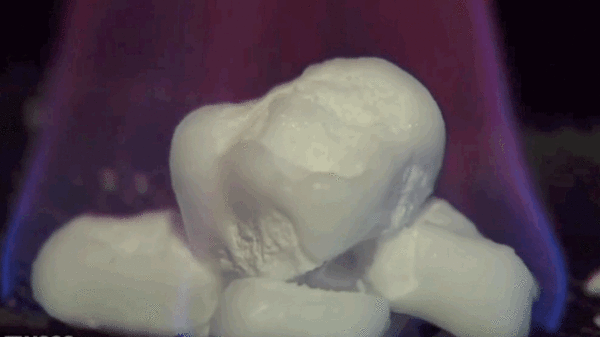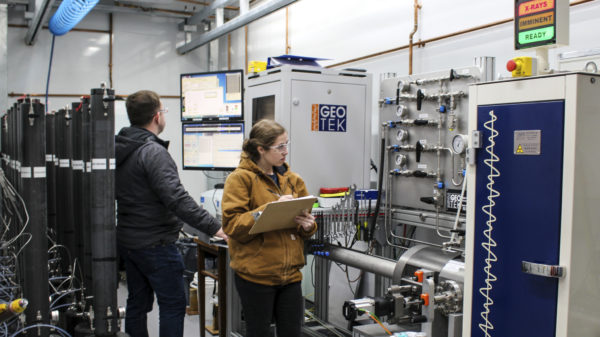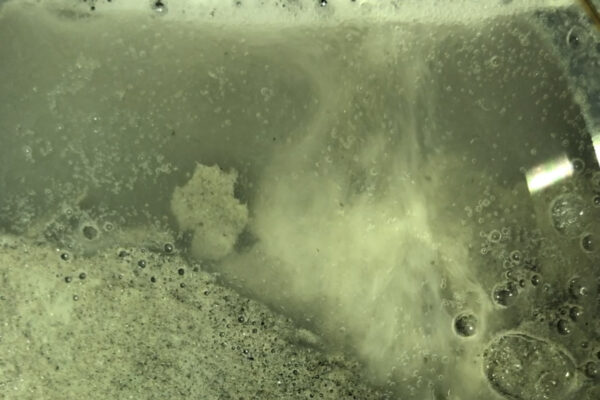“We’re jamming a tiny straw through over a mile of water through over a half a mile of rock in order to pull up 10 feet of ice,” said Peter Polito, an expedition research scientist representing The University of Texas at Austin Jackson School of Geosciences (JSG).
Surrounded by scientific gear, he is standing on the bridge of the Helix Q4000, a semi-submersible deep-water drilling vessel. All around him are massive cranes and robust machinery, and just a bit further out, nothing but rolling waves are in sight.


Methane hydrates could be a bridge-fuel to a carbon-free society
It all seems like quite an enterprise — except the “ice” they are attempting to extract could revolutionize the future of energy.
This 2017 University of Texas Institute for Geophysics (UTIG) expedition was looking for methane hydrates, or methane gas trapped in ice. The substance is made up of water molecules that form a crystal lattice, which contains the densely trapped methane inside. Methane hydrates are abundant in nature, usually found beneath or inside permafrost and buried in sediments under the sea floor.
What’s most significant is that they hold more than 100 times the energy per unit of volume as methane found in the atmospheric pressure at sea level. Essentially, one liter of methane hydrate from the sea floor is 160 liters of methane on the surface.
UT Austin is actively conducting research on these mysterious cores and will be venturing to the Gulf of Mexico again in 2022 to retrieve more samples.

“Methane hydrates could be a bridge fuel to a carbon-free society,” said Peter Flemings, a Jackson School professor and chief scientist of the coring mission.
With its high energy density and large abundance in nature, scientists estimate that the Gulf of Mexico alone holds enough methane hydrate deposits to power the U.S. for hundreds of years into the future.
As resources become more limited, governments are rushing to research alternative forms of energy, and UT is at the forefront of that research, being the first university in the U.S. to have led operations to gather samples of methane hydrates from sand deposits for study.
Although they hold great potential as a viable energy source, extracting them is not an easy process. Methane hydrate is relatively unstable. If you drop the pressure or raise the temperature of the environment even slightly, the material can suddenly become undone and dissociate into its basic components of methane and water.
This all means drilling for cores is an extremely difficult venture, and highly specialized equipment is needed to isolate and contain the substance within pressurized cores in order to properly extract and study them.

In addition to being the first U.S. university to lead expeditions to methane hydrate deposits in sand reservoirs, UT also has the only university-based facility that can safely store and study extracted pressurized cores. At the UT Pressure Core Center, an integrated team of scientists and engineers will continue their research on cores retrieved from this mission.
The stakes are high, but if better studied and understood, methane hydrates could be an enormous untapped reservoir of energy for future generations — especially as coastal countries with limited resources are striving for energy security.
The research also has the potential to shed light on the role methane hydrate plays in the Earth’s carbon cycle. Methane is a powerful greenhouse gas, and scientists studying the cores theorize that natural release of methane from large deposits could have had a hand in periods of past climate change.
Interdisciplinary teams at UT have developed new technologies to better extract cores which were successfully put through their paces during land tests of the equipment last month. With UT at the hub of it all, it’s become a massive collaborative project involving various academic and governmental institutions.


Extracted cores, still in their pressurized state, have been sent to the U.S. Department of Energy (DOE), the United States Geological Survey (USGS), and the Japan National Institute of Advanced Industrial Science and Technology. A number of schools are working on studying the depressurized cores, such as the University of New Hampshire, The Ohio State University, Oregon State University, the Lamont-Doherty Earth Observatory of Columbia University, Georgia Institute for Technology, Texas A&M-Corpus Christi and the University of Washington, while scientists from the USGS, representatives from the DOE and researchers from the Bureau of Ocean Energy Management (BOEM) act as advisers to the project.
“It’s a colossal undertaking that has involved extraordinary efforts and participation at the highest levels of UT,” said Flemings. The land test alone is a $1 million project and is the last stage before UT’s next expedition in the spring of 2022.
As one of many geoscientists, researchers and engineers who have put their hearts and souls into this project, Polito is looking forward to seeing results. “It’s an exciting time,” he said. “Soon, we’re going to know things that no one knew today.”

